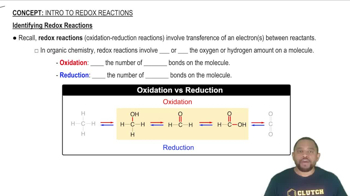Ch.22 - Chemistry of the Nonmetals

Brown15th EditionChemistry: The Central ScienceISBN: 9780137542970Not the one you use?Change textbook
Chapter 22, Problem 83
Complete the exercises below. Hydrogen peroxide is capable of oxidizing: a. hydrazine to N₂ and H₂O. Write a balanced net ionic equation for this redox reaction. b. SO₂ to SO₄²⁻. Write a balanced net ionic equation for this redox reaction. c. NO₂⁻ to NO₃⁻. Write a balanced net ionic equation for this redox reaction. d. H₂S (g) to S (s). Write a balanced net ionic equation for this redox reaction.
 Verified step by step guidance
Verified step by step guidance1
Step 1: Identify the oxidation and reduction half-reactions for each redox process. For example, in part (a), determine which species is oxidized and which is reduced.
Step 2: Write the half-reactions for both the oxidation and reduction processes. Ensure that you include the correct number of electrons to balance the charges in each half-reaction.
Step 3: Balance the atoms in each half-reaction. Start with elements other than oxygen and hydrogen, then balance oxygen atoms by adding H₂O, and hydrogen atoms by adding H⁺.
Step 4: Combine the balanced half-reactions. Make sure the number of electrons lost in the oxidation half-reaction equals the number of electrons gained in the reduction half-reaction.
Step 5: Simplify the combined equation to form the balanced net ionic equation, ensuring that all species are in their simplest form and that the charges are balanced.
Key Concepts
Here are the essential concepts you must grasp in order to answer the question correctly.
Redox Reactions
Redox reactions, or oxidation-reduction reactions, involve the transfer of electrons between species. In these reactions, one substance is oxidized (loses electrons) while another is reduced (gains electrons). Understanding the oxidation states of the elements involved is crucial for identifying which species undergo oxidation and reduction.
Recommended video:
Guided course

Identifying Redox Reactions
Balancing Chemical Equations
Balancing chemical equations ensures that the number of atoms for each element is the same on both sides of the equation, adhering to the law of conservation of mass. This process often involves adjusting coefficients in front of compounds and can require knowledge of stoichiometry to maintain the correct ratios of reactants and products.
Recommended video:
Guided course

Balancing Chemical Equations
Net Ionic Equations
Net ionic equations represent the actual chemical species that participate in a reaction, excluding spectator ions that do not change during the reaction. To write a net ionic equation, one must first write the complete ionic equation and then eliminate the ions that appear unchanged on both sides, focusing on the species that undergo a change.
Recommended video:
Guided course

Net Ionic Equations
Related Practice
